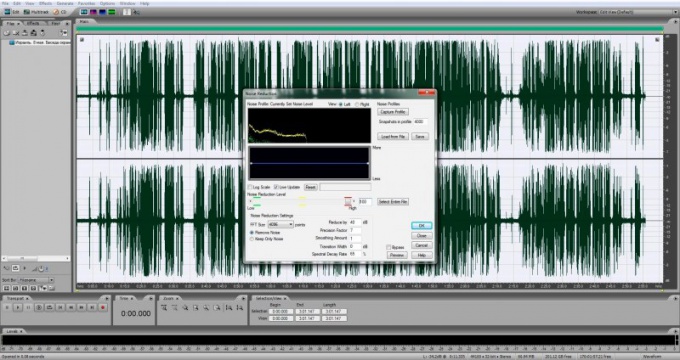You will need
- The computer with installed Adobe Audition, an audio file.
Instruction
1
The program has a group of tools for restoration of phonograms and eliminate unnecessary noise. They are in the tab Restoration. There is almost a complete set for the restoration of the record. The most useful feature for removing background noise is the Noise Reduction (Process). To start working with Noise Reduction, you must first create a profile of the noise. If possible, select a piece of audio containing only noise without useful signal. Highlight it with your mouse, you must go to the Restoration tab, and choose Capture Noise Reduction Profile. The selected fragment will be accepted by the system as reference noise file.
2
After that you can go directly to the effect of Noise Reduction. This requires the allocation of the entire area of the file where you want to eliminate the noise and select Noise Reduction (Process) tab Restoration. A window will open where you can adjust the noise reduction profile. To do this, the tool also includes a slider Low/High and the screen with the equalizer allow you to customize the sound profile so that when noise suppression is not affected useful signal. To check the influence on the useful signal cleaned from noise is possible by moving the box with the line to Remove Noise, Keep Only Noise. If so, check hear not only the noise but also part of the useful signal, the parameters need to be adjusted. Listen to the result using the Preview button at the bottom.
3
Another useful feature in Adobe Audition – Adaptive Noise Reduction. It is applicable to such files, in which there is no net noise profile, that is, plots of useful signal containing only background noise. Control noise reduction Adaptive Noise Reduction is carried out in several sliders allowing you to adjust various options. The tool is not as convenient and easy as the previous one, when working with them requires certain skills. However, it is possible to suppress some of the noise, which can not cope correction on the noise profile.
4
Another tool – Click/Pop Eliminator – useful when digitizing LPS. It can be used to remove a soundtrack of clicks and claps. To do this, select the area of the sound wave where there are artifacts in the form of a sharp short peaks, and choose the Click/Pop Eliminator in the tab Restoration. After opening the tool dialog, the easiest way to get rid of the clicks will be consistent pressing buttons Auto Find All Levels and Find Single Click Now. Note that each click when working with the tool it is better to allocate separately, to reduce the loss of useful signal.
Note
You should never perform dynamic signal processing to noise reduction. Otherwise, noise may be amplified, and the signal is greatly distorted.
Useful advice
When you remove noise you have to consider its level relative to the useful signal. With a loud noise to produce better noise reduction step by step, layer by layer.
